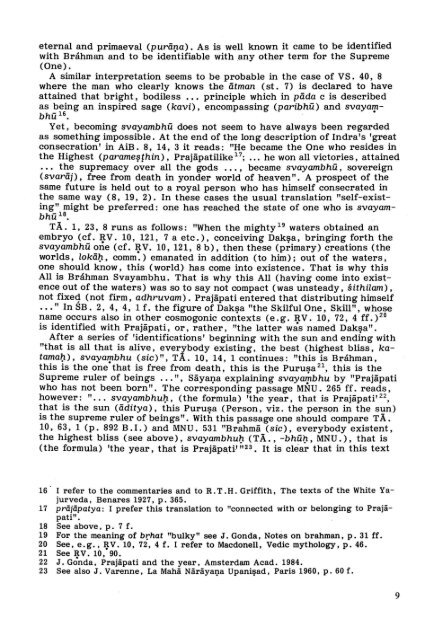Prajapati's relations with Brahman, Brhaspati and Brahma - DWC
Prajapati's relations with Brahman, Brhaspati and Brahma - DWC
Prajapati's relations with Brahman, Brhaspati and Brahma - DWC
You also want an ePaper? Increase the reach of your titles
YUMPU automatically turns print PDFs into web optimized ePapers that Google loves.
eternal <strong>and</strong> primaeval (puräva). As is weIl known it came to be identified<br />
<strong>with</strong> Bráhman <strong>and</strong> to be identifiable <strong>with</strong> any other term for the Supreme<br />
(ane) .<br />
A similar interpretation seems to be probable in the case of VS. 40, 8<br />
where the man who clearly knows the ätman (st. 7) is declared to have<br />
attained that bright, bodiless ... principle which in päda c is described<br />
as being an inspired sage (kavi), encompassing (paribhü) <strong>and</strong> svaya1]lbhü<br />
16. .<br />
Yet, becoming svayambhü does not seem to have always been regarded<br />
as something impossible. At the end of the long description of Indra' s 'great<br />
consecration' in AiB. 8, 14, 3 it reads: "He became the ane who resides in<br />
the Highest (parame~thin), Prajäpatilike 17 ; ••• he won all victories, attained<br />
. .. the supremacy over all thegods ... , became svayambhü, sovereign<br />
(svaräj), free from death in yonder world of heaven". A prospect of the<br />
same future is held out to a royal person who has himself consecrated in<br />
the same way (8, 19, 2). In these cases the usual translation "self-existing"<br />
might be preferred : one has reached the state of one who is svayambhü<br />
18.<br />
TA. 1, 23, 8 runs as follows: "When the mighty 19 waters obtained an<br />
embryo (cf. ~V. 10, 121, 7 a etc.), conceiving Dakl?a, bringing forth the<br />
svayambhü one (cf. ~V. 10,121,8 b), then these (primary) creations (the<br />
worlds, lokä1)., comm.) emanated in addition (to him); out of the waters,<br />
one should know, this (world) has come into existence. That is why this<br />
All is Bráhman Svayambhu. That is why this All (having come into existen<br />
ce out of the waters) was so to say not compact (was unsteady, sithilam) ,<br />
not fixeg (not firm, adhruvam). Prajäpati entered that distributing himself<br />
... " In SB. 2, 4, 4, 1 f. the figure of Dakl?a "the Skilful ane, Skill", whose<br />
name occurs also in other cosmogonic contexts (e.g. RV. 10, 72, 4 ff. )zo<br />
is identified <strong>with</strong> Prajäpati, or, rat her , "the latter wäs named Dakl?a".<br />
After a series of 'identifications' beginning <strong>with</strong> the sun <strong>and</strong> ending <strong>with</strong><br />
"that is all that is alive, everybody existing, the best (highest bliss, katama1).)<br />
, svaya1]lbhu (sic)", TA. 10, 14, 1 continues: "this is Bráhman,<br />
this is the one that is free from death, this is the Purusa 2\ this is the<br />
Supreme ruler of beings ... ", SäyaI].a explaining svaya0bhu by "Prajäpati<br />
who has not been born". The corresponding passage MNU. 265 ff. reads,<br />
how.ever: "... svayambhu1)., (the formula) 'the year, that is Prajäpati,22,<br />
that is the sun (äditya) , this Purusa (Person, viz. the person in the sun)<br />
is the supreme ruler of beings". Witb. this passage one should compare TA.<br />
10, 63, 1 (p. 892 B. 1.) <strong>and</strong> MNU. 531 "Brahmä (sic), everybody existent,<br />
the highest bliss (see above), svayambhu1). (TA. , -bhüi) , MNU.), that is<br />
(the formula) 'the year, that is Prajäpa.U' "23. It is clear that in this text<br />
16 I refer to the commentaries <strong>and</strong> to R.T.H. Griffith, The texts of the White Yajurveda,<br />
Benares 1927, p. 365.<br />
17 präjäpatya: I prefer this translation to "connected <strong>with</strong> or belonging to Prajäpati".<br />
18 See above, p. 7 f. .<br />
19 For the meaning of brhat "bulky" see J. Gonda, Notes on brahman, p. 31 ff.<br />
20 See, e. g. , ~ V. 10, 72, 4 f. I refer to Macdonell, Vedic mythology, p. 46.<br />
21 See RV. 10, 90.<br />
22 J. Gonda, Prajäpati <strong>and</strong> the year, Amsterdam Acad. 1984.<br />
23 See also J. Varenne, La Mahä NäräyaI)a Upanillad, Paris 1960, p. 60f.<br />
9
















